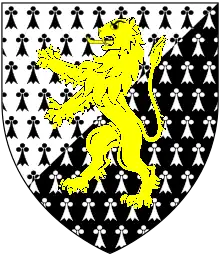Richard Trevor (bishop)
Richard Trevor (30 September 1707 – 9 June 1771)[1] was an English prelate of Welsh descent, who served as bishop of St Davids from 1744 to 1752 and bishop of Durham from 1752 until his death.
Richard Trevor | |
|---|---|
| Bishop of Durham | |
 | |
| Diocese | Diocese of Durham |
| In office | 1752–1771 (death) |
| Predecessor | Joseph Butler |
| Successor | John Egerton |
| Other post(s) | Bishop of St Davids (1744-52) |
| Personal details | |
| Born | 30 September 1707 |
| Died | 9 June 1771 London |
| Buried | Glynde, Sussex |
| Nationality | British |
| Denomination | Anglican |
| Residence | Auckland Castle Glynde Place |
| Parents | Thomas Trevor, 1st Baron Trevor Anne Trevor |
| Alma mater | All Souls' College, Oxford |
Life
Trevor was born Peckham in Surrey, the youngest surviving son of Thomas Trevor, 1st Baron Trevor and his second wife, Anne. He was educated at Bishop's Stortford, then at Westminster School and at Queen's College, Oxford, before becoming a fellow of All Souls in 1727. He became a canon of Christ Church, Oxford in 1735.[2]
Trevor was consecrated bishop of St Davids in 1744, and transferred to Durham in 1752. He was jokingly called 'St Durham' by Horace Walpole and his associates due to his reputation for saintliness, and on his death he bequeathed £3,450 to charities and the poor in the areas in which he had lived. Trevor was also concerned with maintaining high standards among the clerics he appointed.[2]
Trevor was also a builder, remodelling Auckland Castle, the bishop of Durham's palace, as well as his residence at Glynde Place in Sussex, where he also rebuilt the church.[2] A statue of Bishop Trevor was placed in the Bishop's Chapel at Bishop Auckland in 1775 by Joseph Nollekens.[3]
Legacy
After his death, the estate of Glynde passed to his elder brother, Robert Hampden-Trevor, 1st Viscount Hampden.
Art collection
Bishop Trevor was a supporter of the Jewish Naturalisation Act 1753. This interest in Jewish causes is reflected in his purchase in 1756 of 12 paintings by the 17th-century Spanish artist Zurbarán from a series known as Jacob and his twelve sons, depicting the Old Testament patriarch Jacob and his sons.[4] They were installed at Auckland Castle, a property of the Bishops of Durham, and remained in the ownership of the Church of England until 2011, when they were transferred, along with the castle, to a charitable trust backed by philanthropist Jonathan Ruffer,[5][6]
Gallery
 The Honourable and Reverend Richard Trevor, Lord Bishop of Durham; an engraving by Joseph Collyer, modeled after a drawing by R. Hutchinson
The Honourable and Reverend Richard Trevor, Lord Bishop of Durham; an engraving by Joseph Collyer, modeled after a drawing by R. Hutchinson Arms of Trevor: Party per bend sinister ermine and ermines, a lion rampant or
Arms of Trevor: Party per bend sinister ermine and ermines, a lion rampant or
References
- "TREVOR family, of Trevalun, Denbs., Plas Têg, Flints., and Glynde, Sussex". Dictionary of Welsh Biography. National Library of Wales. Retrieved 13 February 2018.
- "Trevor, Richard (1707–1771), bishop of Durham". Oxford Dictionary of National Biography (online ed.). Oxford University Press. 2004. doi:10.1093/ref:odnb/27732. Retrieved 17 June 2023. (Subscription or UK public library membership required.)
- Dictionary of British Sculptors 1660-1851 by Rupert Gunnis p.277
- Bailey, Martin (2011). "Zurbarán sale could lead to National Gallery branch". The Art Newspaper. Archived from the original on 15 March 2014. Retrieved 5 March 2012.
- Lloyd, Chris (25 February 2012). "Prince Charles' charities support for Auckland Castle project". The Northern Echo. Retrieved 5 March 2012.
- "Zurbaran Paintings". Auckland Castle. Retrieved 5 March 2012.
- Lee, Sidney, ed. (1899). . Dictionary of National Biography. Vol. 57. London: Smith, Elder & Co.